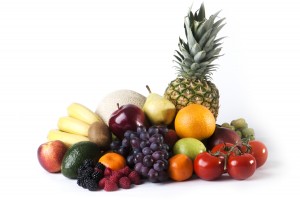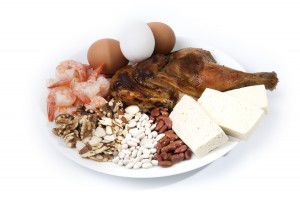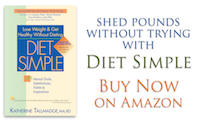Here’s How You Can Get There
- At December 11, 2010
- By Katherine
- In Articles
 0
0
Original Content: Washington Post
I believe that low-carbohydrate diets should be approached cautiously. But if you’re determined to follow a low-carb diet, or if you’re trying to transition from a low-carb diet to a healthier one, here are several tips that will make your experience healthier and the results longer lasting:
• Eat at least 130 grams of carbohydrates daily. In a recent report, the National Academy of Sciences’ Food and Nutrition Board said you need a minimum of 130 grams of carbohydrate for brain function. (Low-carb diets vary but rarely recommend you eat more than 100 grams per day.) To maximize the nutrition and minimize the glucose and insulin response, focus on whole, natural foods and deemphasize processed and refined carbohydrates such as those made with white flour or sugar.
• Eat at least 25 grams of fiber daily. One of the keys to weight loss is to feel full with fewer calories. High-fiber foods help make this happen. Studies show that eating 25 grams for women and 38 grams for men is important for optimum health. Fiber comes in many different forms in food. It is concentrated in the skin of fruits and vegetables, such as apples, corn, and legumes. It is in the seeds of vegetables and fruits such as berries and cucumbers. It is found in the germ and bran or coating that surrounds wheat kernels and other grains. These essential parts of the grain are removed to create white flour and other refined grains.
• Minimize saturated fats. If there’s one thing science has shown fairly conclusively, it’s that saturated fat — found in animal fat — is bad news.
A diet high in saturated fat increases the risk for coronary artery disease by causing LDL (bad cholesterol) levels to rise. New evidence suggests this may also increase the risk for Alzheimer’s and dementia, and even increase belly fat, which is a risk factor for heart disease and diabetes. A diet high in red meat and animal fat has been correlated with several cancers.
To minimize saturated fat, choose seafood, poultry without skin, lean red meats and reduced fat or fat- free dairy products. Concentrate on established healthy fats found in fish, nuts, canola and olive oils.
• Get your essential nutrients. With an intake of approximately 160 grams of carbohydrates a day, you can still obtain the vital nutrients essential to health. Here is a basic breakdown:
• three servings of dairy or
calcium-fortified soy: 36 grams carbs
• three servings fruits: 45 grams carbs
• four servings vegetables: 20 grams carbs
• four servings grains, preferably whole: 60 grams carbs
• Don’t rely on supplements to replace foods. To their credit, most advocates of low-carb diets recommend supplements because they realize the diet is deficient in dozens, if not hundreds, of important nutrients. But supplements can never take the place of real food. A whole, natural food is the perfect package for the vitamins, minerals and beneficial phytochemicals your body needs not just to survive but to thrive. Studies on supplements have failed to show the same health-enhancing and cancer-preventing effects as a diet high in fruits and vegetables.
• Avoid processed low-carb foods. One of the positive things about the low-carb movement is that it persuaded people to reduce their intake of processed, refined foods (a k a junk foods) and instead turn to whole foods. But now the food industry has responded to the low-carb craze with low-carb foods with low nutritional value. These foods undermine the nutritional benefits gained by cutting out processed food. Besides, have you noticed that most of the low-carb foods contain the same number of calories — and often more saturated fat — as their high-carb counterparts?
• Increase physical activity. No matter what you eat, if you’re physically active, your body clears glucose and fat more quickly and efficiently from the blood stream so there is no need to worry about high insulin levels.
• Live a little! If you restrict yourself too much, your diet is doomed to fail. Research shows that those who successfully maintain weight loss reduce the fatty or sweet foods in their diet but still treat themselves occasionally. I’ve found a once-a-week splurge is good for the soul.
— Katherine Tallmadge
Work It In
- At December 10, 2010
- By Katherine
- In Articles
 0
0
Original Content, The Washington Post
You risk losing many of the benefits of calorie restriction once you stop dieting. But I’m convinced you can incorporate many of the discoveries of calorie-restricted diets into your life in a more moderate and sustainable way so that your health benefits can last:
• Exercise. It naturally clears glucose from your bloodstream and that keeps insulin levels low. It creates a condition physiologically similar to calorie restriction. People who are more active have less disease and live longer. Reducing refined sugar and flour may also help reduce blood sugar and insulin.
• Eat more foods high in antioxidants such as green tea and deeply colored vegetables and fruits: Berries, spinach, kale, cabbage and broccoli, pumpkin and carrots are some examples.
• To reduce inflammation, eat more foods high in omega-3 fatty acids — fatty fish such as salmon, herring and sardines, or vegetarian sources such as walnuts and flax seeds. Also, reduce saturated fats, found mostly in animal fats
• Lose weight. It will reduce metabolism, hormones, growth factors and cell proliferation.
• To keep calories at low but healthy levels while still feeling full, increase consumption of high- fiber, high-water- containing, nutrient- dense, low-calorie foods such as fruits, vegetables, whole grains and legumes. Reduce consumption of nutrient-poor, calorie- dense processed and refined foods such as chips, crackers and sweets.
— Katherine Tallmadge
Eat Less, Live Longer?
- At December 10, 2010
- By Katherine
- In Articles
 0
0
Original Content, The Washington Post
Lose weight! Feel great! Live longer!
Every diet guru makes the same claims. But can so many different plans get the same results? Can you achieve the same positive responses from the low-carb, high-saturated-fat Atkins regimen as you do from the abstemiously low-fat, almost vegetarian approach at the other extreme?
This may come as a surprise, but the answer is probably yes. While these regimens seem very different, they share a significant common theme: They restrict your calories and cause weight loss.
Scientists are finding there may be a more straightforward way to not only lose weight, but to avoid heart disease, cancer, diabetes and to even live longer. The secret is to focus sharply on reducing calories.
A growing body of scientific evidence shows that any time you restrict calories you will receive significant health benefits that may not only help you lose weight, but effect a series of biological mechanisms that may prolong your life. (It is important to note that once you go off these diets and if you gain weight, all of the positive benefits are lost.)
It works in animals. Rats fed calorie-restricted diets live 50 percent longer than their normally fed counterparts. Their quality of life is superior, too. They’re healthier, more active, their hormones are at more youthful levels and their immune function is superior. The same is true with fish, flies and worms. There have been preliminary positive results with rhesus monkeys and even humans.
The results of the first human study on calorie restriction, performed at the Washington University School of Medicine in St. Louis, are interesting.
“People on severe calorie restriction have a reduced risk of developing stroke, heart attack, arteriosclerosis and diabetes,” said Luigi Fontana, instructor of medicine at the university’s division of geriatrics and nutritional science and lead author of the study in the Proceedings of the National Academy of Sciences published last month.
“Since 40 percent of Americans die of these causes, these health improvements would increase many peoples’ life expectancy,” said Fontana. “Calorie restriction would also help reduce the 300,000 cases of preventable death due to obesity.”
The kind of calorie restriction being studied shouldn’t be confused with malnutrition (which occurs with starvation or semi-starvation when food is scarce) or in disordered eating. The important difference is while the calorie restrictors cut calories by 25 percent, they eat dietitian-designed, doctor-supervised diets containing all of their essential nutrients. They eat about 20 percent to 26 percent of their calories from protein, 28 percent from fat and the rest from high-volume, low-calorie, nutrient-dense carbohydrates such as fruits, vegetables, whole grains and legumes.
As pure science, calorie restriction makes a compelling case. Anecdotally, we’ve all seen how reducing calories restores health, energy and well-being in our friends and colleagues who are on diets and losing weight. But most don’t continue on those regimens, and, therefore, the benefits don’t last. As a practical matter, long-term severe calorie restriction is probably unworkable for most Americans, and it still hasn’t been proven that it’s healthy or safe for humans in the long run.
“Calorie restriction studies are provocative; but you may end up with deficiencies dangerous for your health,” says Fontana. “Chronic calorie restrictors are taking risks.”
But the research is finding that there are certain aspects of aging that we can change. There are several theories as to why and how calorie restriction prolongs your life. The reasons it reduces disease risk factors and prolongs life are probably varied:
• It lowers your metabolic rate. “The higher your metabolism, the more oxygen your body burns,” says Eric Ravussin, a professor at the Pennington Biomedical Research Center in Baton Rouge, La. “This produces ‘reactive oxygen species,’ which are byproducts of metabolism and are harmful.”
ROS damage the building blocks of life, including protein, lipids and genetic material, DNA. This leads to abnormal genetic signals, causing cancers and disregulation of cells, leading to organ damage, skin deterioration, and maybe even gray hair — all signs of aging.
• Calorie restriction reduces inflammation, which is one cause of many diseases, such as heart disease and arthritis. Also, calorie restriction reduces some “growth factor” hormones.
“When you eat extra calories, your body gets a signal that you’re growing and growth factor hormones promote cell proliferation, which may increase the risk of cancers, among other dangers,” says Fontana.
• Calorie restrictors also have lower hormone levels, body temperatures, plasma insulin levels, and higher levels of the hormone, DHEA. The same is also true about people who live longer, according to the Baltimore Longitudinal Study on Aging, an ongoing study funded by the National Institutes of Health.
• Calorie restriction reduces body fat, which research shows has many benefits.
“We used to think body fat was inert, But it isn’t,” says Fontana. “Fat tissue produces hormones, pro-inflammatory chemicals, which regulate metabolism, the immune system, inflammation and the progression of artery hardening, so that when you have less body fat, you get many biological benefits.”
There are many advantages to calorie restriction. But there are downsides to severe calorie restriction, too. In fact, scientists are not recommending it as a key way to stay healthy, since the research is not complete. Abnormally low metabolism can cause irritability or depression in some people or may backfire and lead to an eating disorder. If you eat too few calories and hormone levels lower too much, this may lead to infertility problems or increase chances of osteoporosis in women.
I believe that one of the real benefits of the low-calorie approach is that it places important emphasis on the central issue: reducing calories, rather than getting diverted into seemingly important, but in fact, peripheral matters, such as carb and fat counting.
Katherine Tallmadge is a Washington nutritionist and author of “Diet Simple” (Lifeline Press, 2004). Send e-mails to her at food@washpost.com.
© 2004 The Washington Post Company
The Numbers
- At December 10, 2010
- By Katherine
- In Articles
 0
0
The Numbers
Original content, The Washington Post
Here are some common foods and their saturated fat content (calories/grams saturated fat):
Butter, 1 tablespoon 102/7
Corn oil, 1 tablespoon 120/2
Olive oil, 1 tablespoon 119/2
Canola oil, 1 tablespoon 124/1
Prime rib, 1 ounce 110/11
Lean roast beef, 1 ounce 47/2
Skinless chicken breast1 ounce 48/0.3
Cheese, 1 ounce 100/6
Reduced fat cheese, 1 ounce 70/3
Whole milk, 1 cup 150/5
1 percent milk, 1 cup 102/1.5
Skim milk, 1 cup 86/0
— Katherine Tallmadge
So Saturated
- At December 10, 2010
- By Katherine
- In Articles
 0
0
Original Content, The Washington Post
Saturated fats are the “evildoers” of the nutrition world, and they come in the guise of some of the most delicious foods: butter, cream, cheese, chocolate, coconut, prime rib.
How could something so good be so bad? Well, first of all, let me assure you that not all saturated fats are created equal. In fact, some of the foods high in saturated fats have redeeming qualities that may mitigate their damage. Second, if there’s one thing I’ve learned in the field of nutrition, there’s never just one magic — or deadly — bullet.
I discovered the power of saturated fats while working with patients. I found when saturated fats are cut to extremely low levels, cholesterol levels drop precipitously. I was stunned at what a simple dietary change could achieve.
The National Academy of Sciences says Americans should minimize their intake of saturated fats, which play a role in raising bad cholesterol (LDL) and increasing the risk of cardiovascular disease, which kills half of all Americans.
Foods contain a mixture of fats, some of which are essential for health. Certain polyunsaturated fats (the omega-3 fatty acids in seafood, flax and walnuts, and omega-6 fatty acids in soybean and corn oil) are essential. You need them in your diet because your body can’t synthesize them, and you’ll develop deficiency symptoms without them.
Saturated fats are nonessential fats, which means that the body can make them on its own, so they’re not needed in the diet. Chocolate and animal fats found in dairy, meat, lard and tallow are high in a saturated fat called stearic acid. While other saturated fats raise LDL levels, stearic acid has been found to have a neutral effect on LDL. In fact, some folks in the chocolate, dairy and meat industries have pointed to this neutral effect as a reason to go ahead and enjoy these foods without worrying about the risk of heart disease.
But a new study appears to challenge this claim. Scientists have found that while it’s true that stearic acid doesn’t raise LDL levels, it still may increase the risk of cardiovascular disease because it increases fibrinogen and C-reactive protein levels in the blood. Fibrinogen and C-reactive protein are both indicators of inflammation, an emerging risk factor in cardiovascular disease development as well as cancer and many other diseases.
“This news is going to change the thinking about stearic acid being neutral,” said David Baer, lead investigator of the study, conducted at the Department of Agriculture’s Diet and Human Performance Laboratory in Beltsville.
In addition to stearic acid, there are three other common saturated fats — palmitic acid (found in palm oil, chocolate and meat), lauric acid (found in coconut) and myristic acid (the most potent LDL-raiser, found in dairy and coconut). These three fats raise not only LDL but also HDL, thus keeping constant that important ratio between the “bad” and the “good” cholesterol. Scientists are not sure how much protection this provides, despite the fact that HDL levels are high. These saturated fats may also cause inflammation, but the research isn’t definitive yet.
But some foods that are rich in saturated fat contain protective, healthy nutrients as well. Chocolate, for instance, contains antioxidants and anti-platelet factors. Coconut also contains antioxidants. There is some evidence that these benefits may help outweigh the risks from the saturated fat. But most experts believe it is still not good to eat large amounts of these foods.
Saturated fats, which are solid at room temperature, have other negative effects. When they’re high in the diet, they replace in the body’s cells the more positive unsaturated fats, which are liquid at room temperature. The saturated fats become incorporated into cell membranes and make the membranes more rigid, causing malfunctions leading to, among other things, insulin resistance.
“Saturated fats can reduce insulin’s ability to control blood glucose and in the long run may cause type 2 diabetes,” says Frank Hu, associate professor of nutrition and epidemiology at Harvard University’s School of Public Health.
Adding to the diabetes connection, a recent Johns Hopkins University study found that dietary saturated fat correlated with higher levels of belly fat, a known risk factor in heart disease, hypertension and diabetes. High-saturated-fat diets may even play a role in dementia and Alzheimer’s disease.
Unsaturated oils do just the opposite. If they’re prevalent in the diet and can compete successfully with saturated fat, they incorporate into the cell membranes instead and increase cell fluidity and flexibility, which is one of many reasons scientists believe they’re so beneficial to overall health.
In fact, there is also a theory that the ratio of polyunsaturated fat to saturated fat in the diet may be more influential in heart disease risk than the absolute numbers — yet another example of the importance of balance in the world of nutrition.
Several large studies have verified that when people replace saturated fat with unsaturated oils, a 40 percent to 65 percent reduction in heart disease deaths can be achieved, especially when a little omega-3 fatty acid is added. Interestingly, these studies showed only a modest reduction in LDL, which illustrates the importance of paying attention to other risk factors such as inflammation.
Comparatively, treatment with statin drugs that lower LDL cholesterol (arguably one of the most prescribed medications today) reduces heart disease deaths by only about 30 percent because it doesn’t remove all the risks. So even when taking statins, dietary change is essential.
“Diet and lifestyle change can work better than statins,” says Ernst Schaefer, director of the Lipid and Heart Disease Prevention Program at the New England Medical Center. “But the problem is compliance.”
Many people find it challenging to reduce the amount of saturated fat in their diets. Life without chocolate or butter seems draconian and a goal that is impossible to meet. But a heart-healthy diet need not be so austere if you keep balance and variety in mind.
The trouble comes with extremes, when you’re eating burgers, fries and a shake — all in one meal. Try this instead: Choose a leaner burger with a green salad and vinaigrette on the side and a bowl of berries and nuts for dessert. The antioxidants from the salad and berries, and the healthy fats from the nuts and vinaigrette just might counterbalance the saturated fat in the burger.
Another solution would be to try to always have surf with your turf. The anti-inflammatory compounds in the omega-3 fatty acids in fish may help counteract the inflammatory compounds in the beef.
“And if you burned what you ate through activity, this all wouldn’t be as much of a problem!” says Baer, research physiologist at USDA.
Know your saturated fats:
Health authorities say that if your LDL is lower than 100, you shouldn’t exceed 10% saturated fat calories. If your LDL is higher than 100, you should keep your saturated fat to no more than 7% of your total calories. I’ve found you can even take it lower, say 3 – 4% of calories- for more dramatic results. But you’ll never get to zero, as a little saturated fat is in just about everything, even some healthy foods!
10% 7% 3-4%
For the typical 2,000 calorie diet, that’s 22 grams, 15 grams, 7 – 9 grams
Here are some common foods and their saturated fat content
cal/g sat fat
Butter, 1 Tbsp 102/7
Corn Oil, 1 Tbsp 120/2
Olive Oil, 1 Tbsp 119/2
Canola Oil, 1 Tbsp 124/1
English Walnuts 185/2
Prime Rib, 1 oz 110/11
Lean Roast Beef, 1 oz 47/2
Skinless Chicken Breast, 1 oz 48/0.3
Wild Coho Salmon 39/0.3
Flounder 33/0.1
Cheese, 1 oz 100/6
Reduced Fat Cheese, 1 oz 70/3
Whole Milk, 1 cup 150/5
1% Milk, 1 cup 102/1.5
Skim Milk, 1 cup 86/0
Chocolate, 1 oz 135/5
Cocoa, 1 oz 75/2.5 (“Droste” Cocoa)
Coconut Milk, 1 cup 452/51
Every Day, in Many Ways
- At December 10, 2010
- By Katherine
- In Articles
 0
0
Original Content: The Washington Post
What are some ways we can eat berries every day?
“A no-brainer,” says Janie Hibler, author of “The Berry Bible” (William Morrow, 2004), “is a berry smoothie for breakfast.” For lunch, she says, throw a handful into your salad. For snacks, carry dried berries and nuts. At dinner, berries go beautifully with meats, grains and main courses. You can also make berry popcicles, syrups for pancakes and spritzers.
Hibler recommends always having berry purees or coulis on hand. “A sauce rivaled by none,” she says. But berries also are great added to drinks, smoothies, yogurts, cereal — you name it.
To make a coulis, rinse and drain the berries, puree them in a food processor and add a little sugar or even liqueur, if desired. It will keep in your refrigerator for three to four days or can be frozen for a month.
Whose Fault is Fat?
- At December 10, 2010
- By Katherine
- In Articles
 0
0
 Original Content, The Washington Post
Original Content, The Washington Post
Trying to lose weight and stay fit seems daunting at times. The proof of our universal difficulties is evident when you consider that most of us — two-thirds of the U.S. population — tip the scales with numbers higher than medical authorities say is healthful.
When my clients occasionally express hardships, I remind them that in our personal struggles to be slender and healthy, we face two fierce, unforgiving forces: our genetics and our environment. The origin of the frustrations we’re facing today can be traced back 100,000 or more years. By then, our genetic code reflected millions of years of evolution, and it hasn’t changed much since. But our environment has changed dramatically in the last several generations — too quickly for our genetics to adjust.
Our genetics guide us toward certain behaviors that we once needed to survive, according to S. Boyd Eaton, professor of radiology and anthropology at Emory University in Atlanta. But in the relative affluence of modern life, these behaviors now may cause us grief — and girth. “There is a dissonance between ‘stone age’ genes and ‘space age’ circumstances,” says Eaton.
So does the mismatch mean it’s impossible to be slim and fit?
We evolved in an environment where food was scarce; we faced regular famines and our food was obtained with great physical exertion through hunting and gathering. To overcome these obstacles, we developed certain characteristics that enabled us to survive.
For one, we feasted when food was available. Those who demurred when there was food around with, “No thanks, I’m not hungry,” probably didn’t survive.
We also became very efficient at storing body fat, according to Eaton, a trait that kept us alive through lean times. And the most concentrated sources of calories — sugar and fat — were most appealing to us. For millions of years, we survived mainly on fruit, according to Eaton, and that created a natural attraction to sweetness; fat tasted good to us because when food was scarce it was an efficient way of getting calories.
On top of that, our ancestors, in their struggle to survive, burned 3,000 to 3,500 calories a day (compared to the average adult rate today of 2,000).
So take these genetic predispositions that have been in place for millions of years and put them into modern life, particularly into the last half century, during which we have created an environment and culture of abundance without precedent. The U.S. agricultural system produces 3,800 calories per person per day, double what most people need — and we barely have to lift a finger to get any of it. Moreover, the marketing, availability, flavor and abundance of that food — much of it high-calorie, low-nutrient processed foods (which earn the most profit) — make healthful eating a challenge for everyone.
“Because of the deadly combination of the availability of fattening foods and our natural desire to eat it, we live in a toxic environment which is a perfect recipe for creating obesity,” says Kelly Brownell, Director of the Yale Center for Eating and Weight Disorders. “If you were starting a society from scratch to maximize the likelihood of people being overweight, it’s hard to imagine doing it much better.”
Brownell, the author of “Food Fight” (McGraw Hill, 2004) lists factors in the environment that make unhealthful eating more likely. Among them:
• Accessibility Studies show we’re more likely to eat whatever is in our environment. And our environment is chock-full of unhealthy, high-calorie foods. Vending machines and drive-in restaurants are open 24/7, fast foods and snack food are abundant in schools, and even places like gas stations and drugstores have become opportunities to buy food.
• Convenience For people in a hurry (and who isn’t today?), unhealthful foods are easier to acquire, whether from drive-in windows or local convenience stores on every corner.
• Taste It’s easy and cheap to make foods tasty by adding fat, sugar or salt. And most people prefer Haagen-Dazs to Brussels sprouts and Big Macs to broccoli.
“Human beings becoming increasingly obese in a world awash in tasty calories and convenience devices is as easy to understand as polar bears, with their thick white coats, overheating under the Sahara sun,” said David Katz, director of the prevention research center, Yale School of Medicine, at the Time/ABC News Summit on Obesity in May. “While it’s true that we have no native defenses against caloric excess or the lure of the couch, we do have one great asset to fix our weight problem: we’re smarter than the average bear.”
Katz, author of “The Way to Eat” (Sourcebooks, 2002), believes in “skill” power rather than will power. “Overcoming an obstacle begins with identifying it. Then we can apply skills and strategies to all of the obstacles we encounter in our efforts to be thin and healthy,” said Katz. We may not be able to change our genes, but we can change our personal environments. And research confirms the most successful long-term weight losers work at avoiding temptations.
Most of your craving and uncontrolled overeating will be conquered when you feed your body the healthful food it needs regularly during the day and you have the food at your fingertips when you need it.
“With the right dose of skill power, rather than will power, we can navigate safely around the nutritional hazards of the modern landscape,” said Katz.
© 2004 The Washington Post Company
Grains of Truth
- At December 10, 2010
- By Katherine
- In Articles
 0
0
 Original Content, The Washington Post
Original Content, The Washington Post
In the world of nutrition there seems to be no shortage of complexity and confusion. But I’ve found that simple and straightforward solutions are often strikingly successful. In no area is this more true than the remarkable power of whole grains.
Over the years, countless clients of mine have struggled with various gastrointestinal complaints such as constipation or irritable bowel syndrome. Many have come to me after trying costly medications, usually with little relief.
In most cases, symptoms disappeared once they began increasing their fiber intake by eating adequate amounts of whole-grain foods. Some of my clients even teasingly call these foods their wonder drug.
But while it’s true that whole grains are valuable for their fiber content, their benefits are much more vast. Whole grains play a profound role in health. A growing body of research shows whole grains — wheat, oats, rice, rye and corn, for example, may help keep body weight down and prevent diabetes, heart disease and some cancers.
The importance of whole grains in health came to light in the 19th century, when refining grains became popular — and its negative consequences were learned. In Asia, chickens were cured of symptoms of a human illness called beriberi, characterized by muscle wasting and nerve degeneration, when they were fed the discarded part of polished white rice. It was later found that the parts discarded during the refining process contain the essential nutrient, thiamin (a B vitamin) necessary to prevent beriberi.
In 1975, researchers Dennis Burkitt and Hugh Trowell published a book of scientific observations comparing the diet of Africans eating their native whole grains versus North Americans and British eating their diet of highly refined carbohydrates. The researchers described for the first time the role that whole, unrefined foods play in reducing coronary heart disease, diabetes and cancer. Since then, numerous other research studies have chronicled the effects of whole grains on human health.
A whole grain has three parts: bran, germ and endosperm. The bran and germ contain fiber, Vitamin E, B vitamins (thiamin, niacin, riboflavin and pantothenic acid) minerals (calcium, magnesium, potassium, phosphorous, sodium, selenium and iron), protein, essential oils, antioxidants and phytochemicals (plant substances that may protect health). The endosperm contains mostly starch with a little protein and very few nutrients. When a grain is refined, turning whole wheat flour into white flour or brown rice into white rice, only the nutrient-poor endosperm is left. The riches found in the bran and germ are lost.
Food manufacturers attempt to make up for the loss in nutrients by enriching refined grains (those found in breads, pasta, rice and cereals, for instance) with some essential nutrients, such as B vitamins and iron.
But overwhelming scientific evidence has found major health differences in people who eat more whole grains compared with people who eat refined grains, proving enrichment doesn’t make up for the difference:
• Whole grains are our major source of fiber. The grain’s outer layer (the bran) keeps us regular and helps prevent hemorrhoids, diverticulitis, and reduces risk for ulcerative colitis (Crohn’s disease).
• Whole-grain intake is strongly correlated with reduced cardiovascular disease. This is partly explained by the soluble fiber in grains (oats, rye and barley have the highest levels), which is associated with cholesterol lowering. But other substances in grains, such as antioxidants like Vitamin E, also play a role.
• People who eat more whole grains also have lower body weights, according to epidemiological research. This is attributed to the fiber, which promotes feelings of fullness in foods that are generally low in calories.
• Many studies have shown a strong link between whole-grain intake and reduced incidence of type II diabetes. This may be partly because the fiber in whole grains slows down stomach emptying, causing a lower rise in blood glucose and insulin. Also, whole grains contain nutrients such as Vitamin E and magnesium, which may help improve insulin sensitivity.
• This research is less consistent, but whole grains may also help prevent cancers, especially of the intestinal tract and maybe even breast cancer. Several theories have been put forth explaining the mechanisms. For one, the fiber speeds intestinal transit, which reduces exposure to potential carcinogens. Also, antioxidants enter the circulation through colon cells, providing long-term antioxidant protection through the entire digestive tract, according to Joanne Slavin, a professor in the department of food science and nutrition at the University of Minnesota in St. Paul. Ninety percent of a grain’s antioxidants aren’t released until they get to the colon, the last stage of digestion, where they may provide maximum protection against cancer.
Interestingly, grains are still a mystery to researchers. They are so complex and full of a multitude of different compounds, scientists are largely unsure of what components of the grain are responsible for the benefits.
“We’re not sure if the benefits are from the fiber or the phytochemicals,” says Simin Liu, assistant professor of medicine and epidemiology at Harvard. “In my opinion, it’s the thousands of phytochemicals in whole grains which produce most of the benefits.”
To prove his point, Liu points to a four-year National Cancer Institute-funded study of high-fiber cereals in which wheat bran was added in the processing as opposed to naturally occurring in a whole grain. Researchers were surprised to find the high-bran diet did not prevent colon polyps, often a precursor to cancer.
“The data doesn’t support the claim that added bran fiber or fiber supplements make a positive difference in colon cancer, which is why I like to use the term ‘whole grain foods’ instead of fiber. The data only point to whole foods,” says Liu.
But while whole grains provide this wide array of health benefits, most Americans don’t take advantage of them.
“American adults eat six to seven servings of refined grains but only one serving of whole grains a day, with children eating less than one serving — well below U.S. Dietary Guideline recommendations of at least three servings,” says Slavin.
While science continues its search for the answers, I recommend you switch from refined-grain products to whole-grain products. Instead of white bread or crackers, choose whole wheat, whole rye or whole grain breads and crackers. Instead of white pasta or white rice, choose whole wheat pasta or brown rice or cereals made with whole oats or whole corn. Try unusual grains such as bulgur (cracked whole wheat), whole wheat couscous or exotic grain-like substances such as quinoa and amaranth.
But looking for whole-grain foods in your supermarket can be challenging. Many “whole wheat” or “multi-grain” breads, for instance, are made predominantly of white flour, even though the label may say “wheat flour.” Be sure the first ingredient on the nutrition label of your pasta, cereal, crackers or bread is a “whole” grain such as whole wheat, whole oats or whole rye. Also look for a whole-grain product containing three or four grams of fiber per one ounce (28 grams) or per 80- to 100-calorie serving. That signifies that the grain is likely in its most natural state.
Katherine Tallmadge is a Washington nutritionist and author of “Diet Simple” (Lifeline Press, 2004). Send e-mails to her at food@washpost.com.
Grain Guide
The grain family includes barley, bulgur, corn, millet, oats, rice, rye and wheat. Amaranth, buckwheat, and quinoa belong to a different botanical family. But they all contain protein, B vitamins, minerals and fiber, as well as antioxidants. Though corn, oats, rice, rye and wheat are relatively easy to find and cook, other of these healthful ingredients may require a search and some guidance before cooking:
AMARANTH This tiny seed, often found in health food stores, can be used to make flour or pasta. Add the seeds to your bowl of cereal, rice or stir-fry.
BARLEY This versatile grain makes a great pilaf or risotto; use the cooked leftovers in a salad, stir-fry or tuna salad.
BUCKWHEAT The seeds of the plant are used to make buckwheat flour, the basis of blini. Buckwheat groats are the hulled and crushed kernels of the seed and are usually cooked in a manner similar to rice. When the groats are toasted, they are called kasha. Add buckwheat to soups, stew, meatloafs or hamburgers. Cook buckwheat groats for a hot breakfast cereal.
BULGUR (also BULGHUR) Made from whole-wheat berries that are steamed, partially de-branned, dried and crushed or cracked, bulgur wheat is available in coarse, medium and fine grinds. A staple of the Middle Eastern diet, it is seen in salads such as tabbouleh or stews. It can also be cooked like a rice pilaf.
MILLET Cracked millet can be cooked like couscous; another variation, pearl millet, can be cooked like rice or a hot breakfast cereal. Millet flour is used in roti, an Indian flatbread.
QUINOA Pronounced “KEEN-wah,” this grainlike product is often found in health food stores. The grain, which must be simmered, has a delicious roasted flavor and can be added to vegetable dishes or rice. Quinoa flakes, a hot cereal similar to oatmeal, make a hearty breakfast.
— Katherine Tallmadge
© 2004 The Washington Post Company
After Atkins
- At December 10, 2010
- By Katherine
- In Articles
 0
0
Original Content, The Washington Post
A new client shared a familiar story with me: This man, who has struggled with his weight for years, went on the Atkins low-carbohydrate diet, and the pounds seemed to melt away. But after a few months, they started to creep back on. Another woman on Atkins lost only part of her desired weight and then hit a plateau. Still others find that after success with Atkins, their cholesterol levels soar, a potential danger to their health. They all came to me fearful that going off the Atkins diet would mean gaining their weight back. But they knew they had to figure out a different way to achieve their goals permanently.
Their fears are well-founded and point to a central dilemma in weight loss: While losing weight is exhilarating and energizing, it also can be fleeting.
“Unless people transition, they’re going to fail, because the Atkins diet produces weight loss but not weight maintenance,” says James Hill, director of the Center for Human Nutrition at the University of Colorado in Denver. “If people lose weight with the Atkins diet, they need to consider their weight loss as Phase 1 and be prepared to keep it off differently, which would be Phase 2.” Hill was co-author of the Atkins diet study published in the New England Journal of Medicine last year. It found that those in the Atkins diet group had a greater weight loss after three and after six months compared with those on a low-calorie, low-fat diet. After one year, though, there was no difference between the two diet groups.
But weight regain is not a problem unique to the Atkins diet. The struggle has been going on for as long as people have been looking for quick-fix, formulaic diets. In the 1970s, people lost weight by cutting carbohydrates with Atkins or Scarsdale. The ’80s brought us high-protein, modified fasts (remember Oprah and Optifast?). In the ’90s, low-fat diets were the rage. Now we’ve come full circle with low-carb diets. All these diets work because they dramatically lower your calorie intake. But the challenge is the same no matter what diet you follow: At some point, you must transition from the diet to a healthy, everyday eating plan that will maintain your weight and enhance your health.
In 1994, Hill and others founded the National Weight Control Registry to study the characteristics of people who successfully maintain their weight losses (known as “maintainers”). People in the registry have lost an average of about 70 pounds and have kept it off for an average of seven years.
The registry and other studies have found many factors that separate successful weight-loss maintainers from unsuccessful regainers:
• Diet: The registry found maintainers eat a low-fat diet with 24 percent of their calories coming from fat, 19 percent from protein and 56 percent from carbohydrates (much of it low-calorie, complex carbohydrates). Only 1 percent eat a low-carbohydrate diet (with less than 24 percent of their calories from carbohydrates).
The registry and other studies have found that maintainers eat more vegetables and fewer calorie-dense foods, such as fried food, fats, fatty meats and sweets, and they often substitute low-fat for high-fat foods.
Maintainers reduce portion sizes, reduce frequency of snacking, and they eat foods such as cheese, butter, high-fat snacks, fried foods and desserts less than once a week. They become satisfied with smaller portions and are less attracted to sweet or fatty foods.
Regainers increase their fat intake while maintainers keep it consistently low. But maintainers don’t completely deny themselves. They changed their basic food patterns, but they allowed themselves fewer but more meaningful indulgences. Regainers, on the other hand, went on very restrictive diets not permitting themselves any room for favorite foods. They felt deprived and easily fell back into old patterns.
• Eating style: The registry found successful maintainers prepare and eat the majority of their food at home, dining out about once a week, which is less often than the general population. The registry and another study found maintainers are more likely to eat five times a day, while regainers are more likely to skip meals, snacking on candies and chocolates more often. The registry found that a strikingly high number of maintainers eat breakfast.
• Self-monitoring: The registry reported that 75 percent of maintainers weigh themselves at least weekly or daily. This helps them nip any minor weight gains in the bud. On the other hand, regainers either accept larger weight gains or don’t notice their weight creeping up until they gain a large amount. One study found that successful maintainers develop a “healthy narcissism” about their appearance and physical condition. The registry and numerous studies have found that maintainers monitor their eating by occasionally keeping food diaries to increase awareness.
• Physical activity: Nine out of ten of the registry participants engage in regular physical activity. “During weight loss, diet is the driver. But during weight maintenance, physical activity becomes the key,” says Hill, whose new book, “The Step Diet” (Workman, 2004), incorporates elements from registry findings.
• Coping skills: Most people have comparable levels of stress and unpredictability in their lives, but some are able to handle it more effectively than others. Maintainers are more likely to face their problems, while regainers react emotionally or avoid problems by sleeping, drinking or eating. Maintainers are also more likely to seek support from friends, family and professionals.
• Lifestyle: Many maintain weight loss only upon making major lifestyle adjustments. One study found when home-bound women became more involved in activities outside of their homes, they were more likely to maintain weight loss. They became more confident and took responsibility for their lives and their size. The activities you choose to engage in and the people you spend time with influence weight-maintenance success. Often this means making new, healthier friends and including spouses in your lifestyle changes. Spousal support is necessary for long-term success, even if it may not be necessary short term.
• Goals and expectations: Maintainers are more likely to be patient, setting small, reachable goals. They accept dietary change as part of their lives rather than as part of a temporary diet. They realize they need to be continually conscious of their food and activity levels and work at staying in shape.
The evidence is clear: The battle of the bulge is won at the margins. Sweeping dietary overhauls are impractical and don’t work over time. Shrewd, small, concrete changes that can be easily incorporated into your daily routine lead to success.
Katherine Tallmadge is a Washington nutritionist and author of “Diet Simple” (Lifeline Press, 2004). Send e-mails to her at food@washpost.com.
© 2004 The Washington Post Company
Accept No Substitutes: Dangerous Supplements?
- At December 10, 2010
- By Katherine
- In Articles, News
 0
0
 Original Content, The Washington Post
Original Content, The Washington Post
Taking multivitamins, Vitamin B-6, Folic Acid, Magnesium, Zinc, Copper, and particularly Iron, may increase death rates, according to a recent study published in the Annals of Internal Medicine. Only Calcium and Vitamin D were correlated with positive benefits.
Let me explain…
Many of us want to include nutrients, the right vitamins and minerals in our diet. But we often don’t want to eat all the foods and calories required to get this balance. What we’re looking for is a magic supplement that will give us more energy, improve the quality and length of life and prevent the chronic diseases of today such as heart disease, cancer and diabetes.
While we know that certain foods have been shown to provide these benefits, can the right supplement do the same?
Leading researchers are increasingly convinced that while supplements can serve many positive purposes, they cannot take the place of a well-balanced diet, and may even be dangerous.
The Importance of Food
“The thousands of vitamins, minerals and phytochemicals [beneficial plant compounds] in whole foods act synergistically together to create a more powerful effect than the sum of their parts, producing a result which cannot be recreated by supplements,” says Jeff Prince, vice president for education at the American Institute for Cancer Research.
Over the past century, nutrition experts gained a fuller appreciation of the need for a plant-based diet. Research began to show in the 1970s that certain patterns of eating, beyond vitamin and mineral intake, were influencing illnesses.
By the 1980s, they found that populations that ate more fruits, vegetables and high-fiber foods experienced lower rates of cancer, heart disease and diabetes. Also, by that time, discoveries had been made that newly discovered phytochemicals and certain vitamins and minerals acted as antioxidants and might prevent chronic diseases such as cancer and heart disease. After all, it had been found that people with high blood levels of two antioxidant vitamins (a form of vitamin A called beta carotene and vitamin E) had reduced lung cancer rates. It had also been observed that people who ate more dark-green leafy vegetables (high in beta carotene) experienced less lung cancer, even if they smoked.
Sensing a major breakthrough, the National Institutes of Health funded one of the biggest studies ever conducted. Known as the ATBC (Alpha-Tocopherol, Beta Carotene) Cancer Prevention Study, published in the New England Journal of Medicine in 1994, it tested the theory that the antioxidant vitamins beta carotene and alpha-tocopherol (vitamin E) would prevent lung cancer in smokers, the highest-risk population. After following 29,000 male smokers for six years, the stunned researchers found “a higher incidence of lung cancer among the men who received beta carotene supplements than among those who did not. In fact, this trial raises the possibility that these supplements may actually have harmful as well as beneficial effects.”
Needless to say, these revelations sent shock waves through the scientific community. “This study was a turning point in the nutrition field, especially when multiple studies kept confirming that supplements didn’t work at preventing cancers and heart disease,” says David Klurfeld, national program leader for human nutrition at the USDA’s Agricultural Research Service. “People think that we can pull out the fiber, pull out the antioxidants. But research does not back that up. Study after study says you gain the most benefit from whole foods.”
That is not to say that supplements are of no use. They can be of great benefit, when taken based on individualized needs. This study, and others like it, stress the importance of personalizing your supplement needs by reviewing your medical, family and personal history, your food intake, THEN and only THEN, decide what you might be lacking and make an educated decision, preferably with the help of a registered dietitian and your doctor. Supplements simply can’t compete with better food choices. Consider these findings:
• When the ATBC Cancer Prevention study data was re-analyzed years later for consumption of fruits and vegetables, researchers found that while supplements did not prevent lung cancer, eating fruits and vegetables high in beta carotene (e.g., carrots, sweet potatoes), lycopene (e.g., tomatoes) and lutein/zeaxanthin (deep-green leafy vegetables such as spinach and kale) reduced lung cancer risk.
• A diet high in cereal and vegetable fiber (35 grams versus 15 grams) reduces the risk of colon cancer by 40 percent, according to recent findings in the EPIC (European Prospective Investigation into Cancer and Nutrition) study. But studies of fiber supplements have failed to find any benefits and some have found an adverse effect.
• A diet high in fruit reduces lung cancer risk by 40 percent, also according to new EPIC study findings. Another study found subjects with a high fruit intake had a 44 percent lower risk of lung cancer compared with subjects eating the least amount of fruit. But when subjects added beta-carotene supplements, there was no benefit from the fruit.
• Men who ate 10 servings of tomato products weekly reduced their risk of prostate cancer by 35 percent compared with men who ate fewer than 1.5 servings, according to a Harvard Health Professional study. While the benefit is largely attributed to the phytochemical lycopene, trials of lycopene so far have found it is less potent than the tomato.
• A diet high in fruits and vegetables reduced stroke risk by 28 percent, and fruit alone reduced the risk by 40 percent, according to a study published in the American Journal of Clinical Nutrition in 2003. No dietary supplements have been found that significantly reduce stroke risk.
• People who ate collard greens or spinach two to four times per week had a 46 percent decrease in risk for age-related macular degeneration (the leading cause of blindness) compared with those who ate these vegetables less than once per month, according to a study published in the Journal of the American Medical Association this year. No studies have found supplements prevent or improve macular degeneration.
• People who eat more soy have a decreased risk for coronary heart disease, breast cancer and prostate cancer. But when various components of soy foods have been isolated and studied, these finding have not been replicated, and some have found adverse effects.
• A diet high in antioxidant-rich foods helps prevent cardiovascular disease, but the studies of individual antioxidant supplements have been so inconclusive that the American Heart Association recently issued an advisory against taking them to reduce cardiovascular disease
“Researchers are working as fast as we can to find the most effective components in foods,” says Janet Novotny, research physiologist at USDA’s Human Nutrition Research Center in Beltsville. “But so far, studies have shown that while fruits and vegetables are associated with decreased risk of chronic disease, studies of the isolated compounds in fruits and vegetables haven’t shown an effect.”
Food and dietary patterns are complicated and expensive to study, and can defy the brightest minds and best intentions. In the meantime, the best advice is to eat a plant-based diet with at least five to nine servings of fruits and vegetables (you’ll get the most benefit with the higher amount), at least three to four servings of whole grains and regularly eat legumes as a side dish or occasionally as your protein source.














